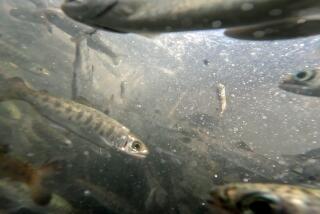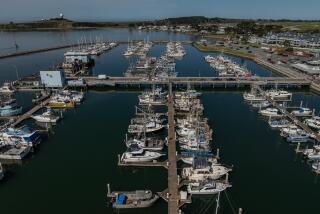A happy ending for biologist but not the pike
SACRAMENTO -- For half a dozen years now, Ivan Paulsen has ventured where few wildlife biologists dared: the thorny political thicket of exterminating the pike of Lake Davis.
Last week, Paulsen quietly watched the fruits of his labor unfold. Without a hitch and hardly a whimper of dissent from Lake Davis locals, California Fish and Game crews laced the Sierra reservoir with poison in a last bid to slay the northern pike, an invasive fish authorities fear could escape and wreak havoc on the state’s fragile inland fisheries.
The workweek’s end saw the conclusion of the project for Paulsen -- and the end of a career. Friday marked his last day with the Fish and Game Department, and the start of retirement with his wife in a house they’re building by a lake in Minnesota.
Paulsen also hopes it’s the end of California’s pike problem.
For a decade, political repercussions over pike have bedeviled Lake Davis, 100 miles northeast of Sacramento.
Back in 1997, folks in the nearby Sierra town of Portola blew a civic gasket when the state decreed that Lake Davis would be pumped with the poison Rotenone to slay the saw-toothed invader from the Midwest.
The poisoning was a flop on all fronts. The pike returned within 18 months, and the townsfolk of Portola were in a torch-and-pitchfork mood.
Enter Ivan Paulsen.
An avuncular sort with graying hair, a trim mustache and blue-eyed twinkle, Paulsen admits now that back in 2000 he had a bit of apprehension about becoming chief biologist for pike extermination part 2.
But aside from scientific smarts, he brought his own mild-mannered, Midwestern demeanor. Paulsen quickly took to the role of goodwill ambassador to a community feeling more than a mite touchy over what most considered imperious treatment by the state.
Paulsen says he spent those first months “mending fences” left in tatters from the last go-round. He recalled that “ ’97 was tough on everyone -- the community and Fish and Gamers.”
To earn trust, the biologist moved to the region and set up an office right in Portola. In the months and years that followed, Paulsen took pains to mosey up to locals with more than a tad of humility, a willingness to listen and the gumption to exhaust every remedy known to man.
They tried explosives in Lake Davis. They tried electric shocks. They hired commercial fishermen. Nothing put a dent in the explosion of the pike population.
Meanwhile, Paulsen became the local pike guru. He and his team worked hard to tactfully educate the people of Portola and neighboring mountain burghs of the need to exterminate the pike.
He noted that pike, probably dumped in the lake by an unknowing angler eager to introduce a hard-fighting game fish to the West, were indeed magnificent in their own way. But not in California, where the fish could quickly assume the top rung on the aquatic food chain.
If they escaped Lake Davis, pike could rapidly extinguish the state’s fragile salmon and steelhead trout runs. They could eventually migrate downriver to wreak havoc on the endangered fish of the Sacramento-San Joaquin River Delta, further crimping water exports to Southern California.
As Paulsen amiably puts it about the audience reception, “Reasonable people can understand why pike shouldn’t be here.”
It was plain to most folks what pike had wrought, savaging both the reservoir’s trophy-sized trout and a tourism economy dependent on visiting anglers.
Slowly but inevitably, Paulsen and the community came around to the consensus that a new, more effective round of poisoning seemed the only way to free Lake Davis of pike.
When the big day came Tuesday to unleash the flotilla of two dozen boats and dump more than 15,000 gallons of liquid poison into the lake, Paulsen half expected to see a few protesters with picket signs.
Instead, he drove through town to find placards offering thanks to the Fish and Game Department.
“What a huge difference from ‘97,” Paulsen said. “It was very gratifying and humbling to see that all the work we did paid off.”
As the fish went belly up, department crews scoured the shores on foot and searched the lake depths with nets, loading more than 600 clear plastic bags with nearly 10 tons of fish the first day alone. The bags included a few big trout that had survived the pike, but bore the teeth marks of underwater attacks. There also were loads of brown bullhead catfish and shiners and sunfish.
But nearly one in 10 fish hauled in was a pike. The biggest measured nearly 4 feet long and weighed more than 20 pounds, Paulsen said.
He heads off now to retirement, praying the pike stay away for good. Paulsen is not making promises, just offering hope.
“We feel good that we’ve done the best we can,” Paulsen said. “But there are no guarantees in life except death and taxes.”
--
More to Read
Sign up for Essential California
The most important California stories and recommendations in your inbox every morning.
You may occasionally receive promotional content from the Los Angeles Times.










